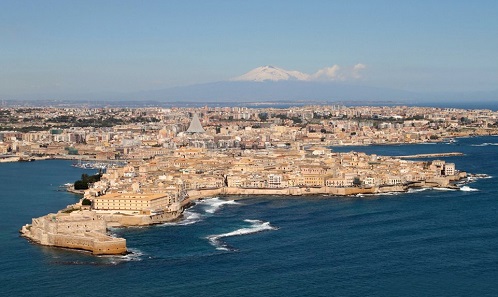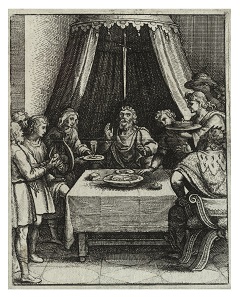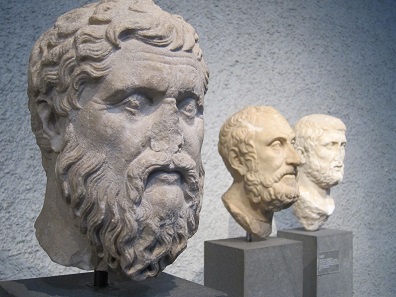translated by Sylvia Karges
With the victory over Athens the war between Selinunte and Segesta was still not over – even though, with the defeat of the Athenian fleet, Segesta’s most important ally had dropped out. Now the city fathers tried to win over Carthage for support and the plea was successful. In a triumphal procession, the Carthaginian army conquered first Selinunte and Himera, then Acragas.
View of Syracuse from the peninsular of Ortygia. Photo: I fratelli Angelo e Biorgio Bonomo from Pomezia, Roma / Wikipedia.
Dionysius I, 405-367
Syracuse did not succeed to undertake a necessary step, which is why the people’s assembly voted for the young, energetic, but still unknown Dionysius to become sole commander and have his personal guards. Syracuse created a new tyrant for itself and at first he wasn’t much more successful than his democratic predecessors: Gela was conquered by the Carthaginians, Camarina had to be evacuated. But before Syracuse itself was at serious risk, Dionysius entered into a treaty with Carthage.
Why the victorious Carthaginian commander was willing to do that still remains a mystery. Ancient authors assume responsible an epidemic plague, decimating his army. Included in the treaty was also a clause, which secured Dionysius’ rule over Syracuse. Out of all provisions of the treaty, this paragraph remained intact the longest.
Damocles’ sword hangs over Dionysius I. – If Damocles ever lived, we don’t know. Nevertheless, Cicero tells us this story as a metaphor for the constant dangers a tyrant is exposed to. Source: Wikipedia.
Our knowledge of the tyrant Dionysius we especially owe to Schiller and his poem “The Hostage“. At the time of the Weimar Classic, Dionysius was still considered an absolute tyrant. He came from the upper Syracusan class and was only 25 when he took power. His rule seemed to have anticipated the Hellenistic ruler type.
View over Euryalus Castle. Photo: Salvo Cannizzara / Wikipedia.
Dionysius didn’t confine himself to Sicily. During the height of his power his domain included the entire island, except the very west, and the tip of the Italian boot up until the Gulf of Taranto. He had allies in Epirus and Southern Italy on whose military support he could count.
On the island of Ortygia Dionysius built a castle, which only his abiders were allowed to enter. Rumors about his misanthropy overgrew his historical figure, which makes it difficult for today to draw an accurate picture of him. But the fact remains, that he exercised rigorous power politics: He maintained the Sicilian tradition of resettling the population of whole cities; he did not have any scruples to obligate people to forced labor, he took money from wherever he could get it from – in short, the expansion of his power was done at the expense of the welfare of his subjects. On the other hand Dionysius fought against the Carthaginians, which encouraged authors of later times to stylize him to the protagonist of the Greek cause against the Barbarians.
Dionysius II, 367-344, and Dion
His son, Dionysius II did not posses the strong personality of his father. Taking over rule did not cause any big problems, but soon the new tyrant of Syracuse withdrew to the Southern Italian city of Locri. There, he is said to have dedicated his life to wine, music and philosophy. A treaty with the Carthaginians, which had finally brought an end to the devastating war on Sicily and which resulted in peace for almost 20 years, allowed him this life of idleness.
Head of Plato. Basel / Archaeological Museum. Photo: UK.
In the beginning of his rule he was supported by an older and experienced relative: Dion. In 388/7 Dion had met and learned to appreciate Plato the Philosopher, when he had privately traveled to Southern Italy. Perhaps it was the concern about the future of the state which led Dion to invite Plato to educate the young tyrant Dionysius to be a philosopher. Anyway, Plato came, but wasn’t able to incite the hedonistically young ruler to a life for the good of the state. Disappointed by reality, Plato returned to Athens. Even a second visit to Syracuse failed miserably.
In the meantime, Dionysius and Dion had a falling out. The once highly esteemed counselor was in Athens, his freely chosen exile, when in 361/0 he received a message stating that he was now also officially declared ostracized. At this time he was studying at the Academy in Athens. And it was there where he found followers who were willing to fight in order to see a philosopher on the throne.
In 357 Dion went to Syracuse with about 1000 soldiers. Without a fight the city was his. For 3 year he was able to secure the city when he was murdered by his former ally Calippus. The reasons are unknown but must have been personal. In 346 Dionysius II came back to Syracuse for a short while. As a result, a former follower of Dion went to the old Mother City of Corinth to ask for help against the tyrant. And indeed, Corinth, entirely unexpectedly, sent a small army under the command of Timoleon to Sicily.
In the next part, you will find out how Timoleon brought peace to Syracuse and how, after his death, Agathocles seized power.
This article was originally published in MünzenRevue 4/1997.
Please find all parts of this series in our archives.
If you are interested in Sicily, you should certainly check out the numismatic diary “Sicily in full bloom”. Find this series also in our archives.







